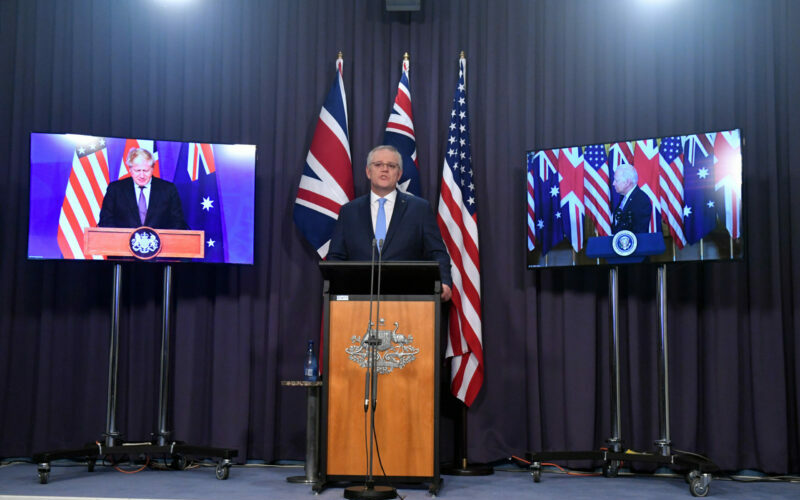
Australia’s dependence on the United States is rooted in its anxieties about being a small, settler-colonial states.
One defining quality of the American alliance usually ignored or misrecognised is the imperial character of the United States as a global power. In particular what is important to recognise is not just what Paul Keating spoke of rather coyly recently as “the rudeness of great powers” when referring to China.
That and more has a very long history in the case of the United States. Moreover, the origins of the United States as a settler-colonial country expanding continually westward from the Atlantic cast in land-grabbing genocide are not spoke of in polite company by most media and academic analysts of international relations, who often lose their way in miasmas of “American exceptionalism”.
Most important of all is to emphasis e the American form of empire, beyond the particular form of capitalist economic power it projects and protects, is distinctive for one unusual organisational form of military power deriving from the fusion of two systems. On the one hand, there is a readily visible form of material power represented by the more than 1000 United States military bases outside its own territory, and on the other the less visible but critical and equally potent digital networks of the US government communications and computing infrastructure that the US military calls the Global Information Grid (GIG) — the globe, of course, being in American eyes presumptively US territory.
The scale of this imperial enterprise is clear in the Defense Department’s definition of the GIG as:
“The globally interconnected, end-to-end set of information capabilities for collecting, processing, storing, disseminating, and managing information on demand to warfighters, policy makers, and support personnel.”
Contemporary Australia is a case of dependent high-technology liberal militarization that takes much of its character from the placement in the American empire of bases. Australia exhibits distinctive characteristics pointing to a model of militarization that must look beyond standard concerns with increasing national defence budgets, more and better weapons systems, an “exceptionalist” approach to immigration security, and a predilection for use of military force in international affairs.
In a world and time where militarisation is a global norm embedded in globe-spanning military alliances and world-wide networks of foreign military bases, discerning the lineaments of one particular national instance can be both difficult and potentially misleading.
In liberal democracies such as Australia, national self-conceptions resist identification with the harsh implications of reliance on or valorisation of military force — “That couldn’t possibly be us, could it?” — unless it can be viably represented as defence of freedom, just war, or wars against unspeakable Others.
And in the case of liberal democracies originating in a settler state and ongoing unrecognised conquest of indigenous peoples — think Australia, the United States, Canada, Israel — the racially-inflected violence of the foundations of state-formation and national identity continues to ramify through the default settings of contemporary foreign policy.
All three qualities distinguish the contemporary pattern of Australian militarisation from the standard versions of either exceptionalist or liberal militarisation.
Over the past half century or more, the standard historical parameters of Australian defence policy have focussed on oscillations around a set of policy polar tensions:
- self-reliance vs imperial or super-power dependence;
- confidence in sufficient warning time to prepare for emerging major threats vs. identity rooted in fear of invasion;
- acceptance of limited resources and influence vs. borrowed grandiosity by association with imperial allies; and
- force structure designed for the defence of continental Australia and the immediate region v “operations in distant theatres”.
These tension sets derive at root from the anxieties of a small settler-colonial state, uneasily occupying a conquered continent, identifying deeply with its imperial origins on the other side of the world, and fearfully anxious about its relations with its geographical and cultural environment. Identity powerfully structures how the map is read for strategic interest. On the standard Australian reading, “help” is seen as far away. Serious pursuit of “self-reliance” is seen a brave gamble.
The historical roots of this pattern of dependent militarisation then suggest that hopes for deep change will require a double political movement. One is directed externally and starts from a familiar argument of the need for Australian independence from imperial ties. Former Prime Minister Malcolm Fraser emphasised the strategically dependent character of Australia since Federation and before. Fraser was both serious and accurate when he said that he had never lived in an independent Australia.
The other, directed internally, is less familiar — or perhaps better put, is recognised in glimpses, but not accepted at heart as even more compelling, more urgent and more difficult to achieve. This involves a re-forming of national identity which
- is not rooted in the inherently racialised Anglosphere;
- involves open recognition of the foundation of the Australian state in an act of conquest, the consequences of which are still unfolding;
- understands the extent to which the achievements of contemporary Australia rest on a comforting selective historical memory of actual connected and often exploitative history to other parts of the world; and
- builds on the uneven achievements of multiculturalism to build Australian cosmopolitan solidarity with the peoples in the geographical and cultural region in which we live.
This is part four of an edited extract of Richard Tanter’s submission to the Independent and Peaceful Australia Network People’s Inquiry in US-Australia Alliance, September 2021. Read parts one, two, and three. Next: Australia’s role in global conflicts.




